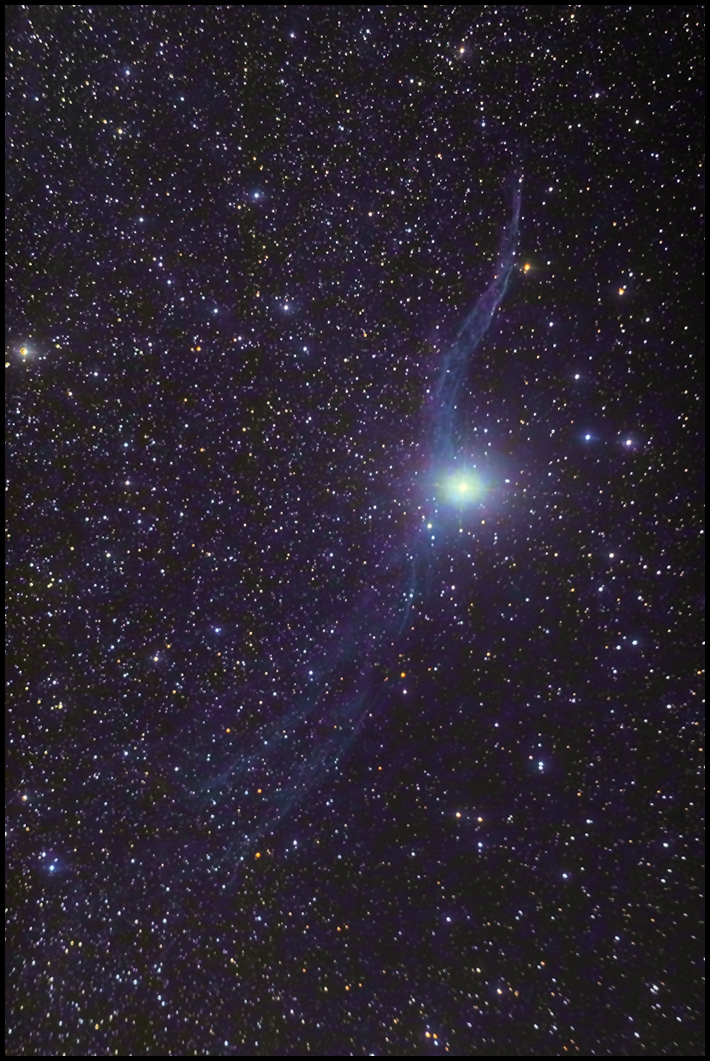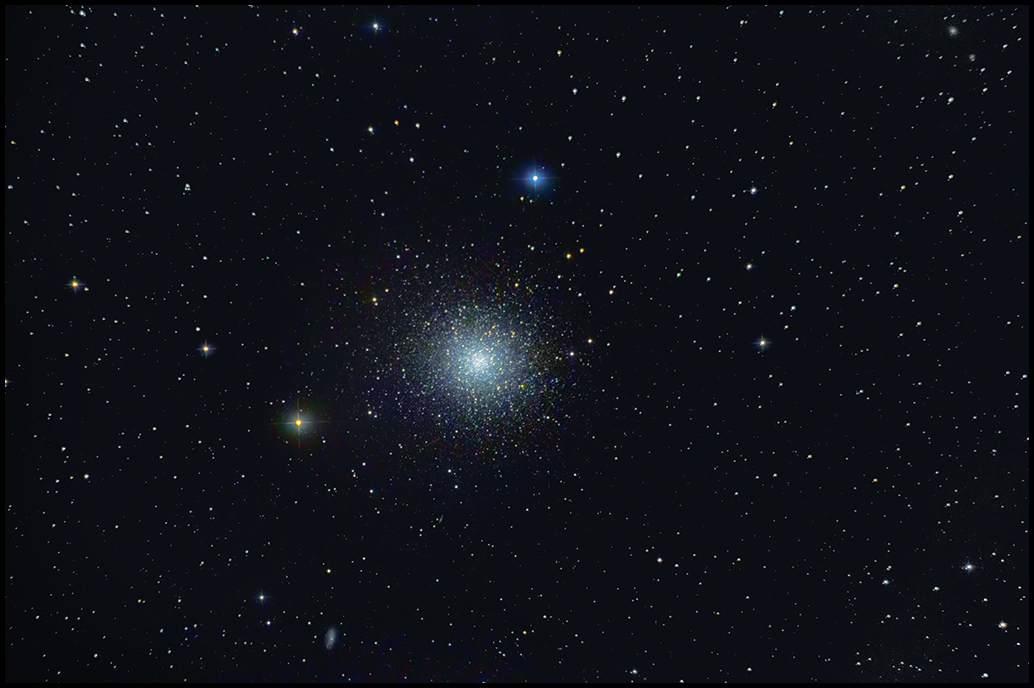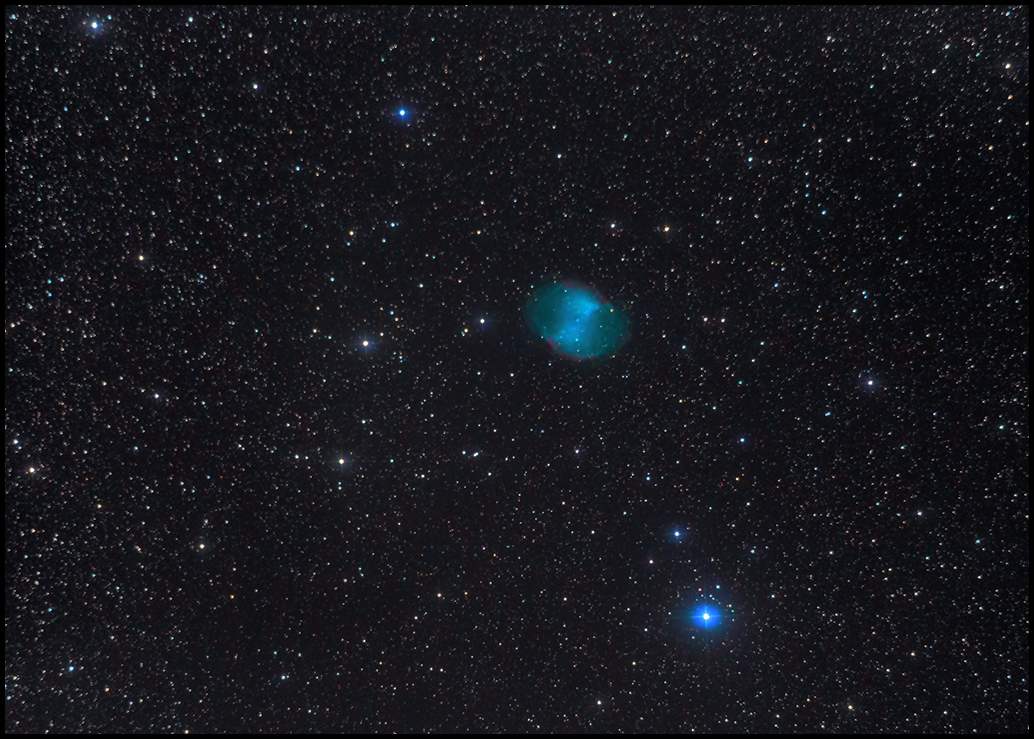8/26/2014. The Crescent Nebula and the eastern half of the Veil. Several experiments with flats were informative, but the best advice came from Michael Covington's website where he explains that EOS cameras have very high pedestals, up to level 1024 in some cases, and that bias frames are vital. Shoot subjects that hover at and below 1000e- without using a bias frame, and you'll get weak results, at best. In fact, as Covington suggests, the same image can be used for both bias and flat. I shot six flats by daylight (1/4000s) and told Maxim DL to use them as both bias and as flats. This recovered faint detail very nicely. I applied a 7x7 blur using Maxim's kernal filters. Possibly it makes more sense to apply the blur to the flat and to use the unmodified frame as bias. For each image, I took color data from a single sub and added it to the stack. Note that what looks like coma is only present when I manually align the frames.

Crescent Nebula
25x30s, ISO 3200

Veil Nebula
97x30s, ISO 3200
The Crescent frames aligned nicely with star detection, but the Veil required manual, 2-star alignment. And then Maxim bogged down during multiple combinations using different parms. Probably want to keep the number of massive CR2 images down some which is another reason, along with deeper subs and the ability to use narrow-band hardware, for getting the guiding working. After the first of the month.
8/27/2014. More practice. M13 and M27. M27 has always been a tough starhop for me, and it was again tonight. It was nice to be able to spin the ISO up to 25600, take a 5s exposure and see very clearly what was where. Even so, I wasted over half an hour lining it up. I shot bias frames with the lens cover in place and flats by afternoon skylight, diffused. I processed them to TIFFs in BreezeBrowser then averaged them in Maxim, converted to mono, and took a 3x3 gaussian blur. The bias frames were simply averaged in Maxim with color-conversion unchecked. That workflow is still up for grabs, but it's coming along. Right-click and "view image" on the following two images for 1024-pixel renditions:

M13
81x30s ISO 3200 (42m total)
1 30-second sub used for RGB

M27
64x30s ISO 3200 (total 32m)
1 30-second sub used for RGB
The Kendrick battery pack started the night at 11.95V and when I shut everything off about 4 hours later, it was down to 10.52V. I think it needs a replacement battery. When I install one, I'll make provision to plug in a second source. [9/10: I replaced the battery with another 18AH said to be suitable for deep cycle use and drilled a hole in the metal box to admit leads to another battery, but have not attached any yet.]
The full M27 image shows classic coma (mostly cropped here; 4k images are good enough, the full 5.5k frames suffer some). I think the EOS/MPCC spacing is just a little off. It stands to reason, actually, since Canon lens spacing is a little shorter than Nikon's. A few mm may make a big difference to the small coma remaining. O the joy! More testing.
9/28/2014. Yes, it has been cloudy for a month, why do you ask? When it's cloudy, the kit gets churned. An amateur in Texas is modifying his portable outfit (too) and offered a set of AstroTech fixed rings that fit the ST80. They would hold it rigidly, lower, and lighter than any mounting scheme I've tried so far. It does make an excellent finder, and I intend to give it another chance in that role. Wasting half an hour to find a bright M-object in the 9x60 was instructive. The ST80 would also be a good guider atop the R-C when using a DSLR.
It balanced well, but... using the fixed rings put a premium on the alignment of its support. In its first trial, the aiming point for the 10-inch was in the outer quarter of the ST80's field of view. Tedious. I rethought the attachment of the collimating rings and re-installed them without the fancy Losmandy clamps and spacers. That saved substantial weight and lowered the ST80 by an inch or more. Now the ST80 balances nicely and can be aimed precisely. The fixed rings may yet have a career as guider supports on the R-C. And since it's only a finder (not a guider) on the 10-inch, I could use something less rigid than the 1-inch square aluminum beam that holds it now. I could lower it another 3/4 inches, easily. But please: only if necessary! Enough fiddling. Let's make some pictures.